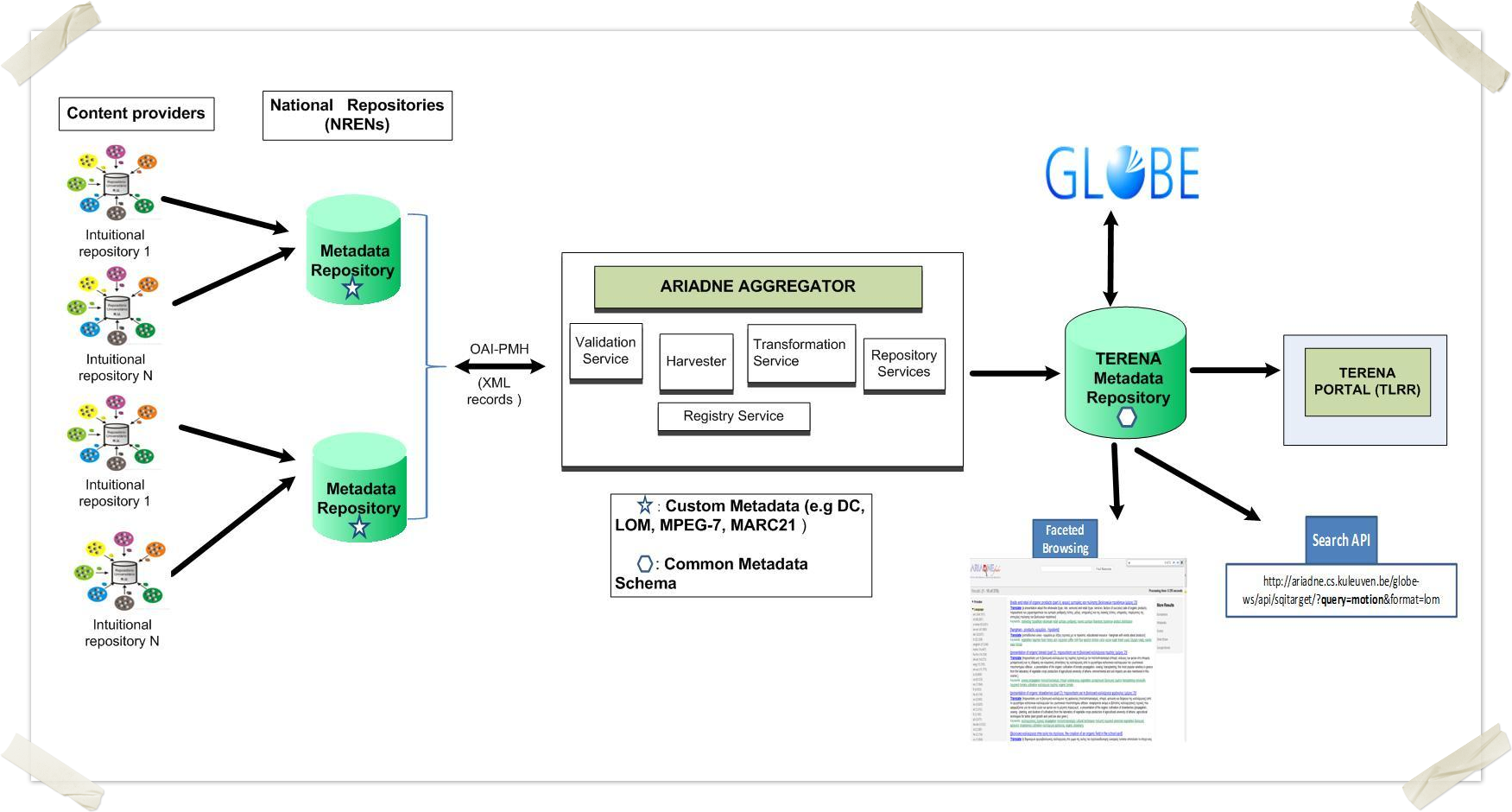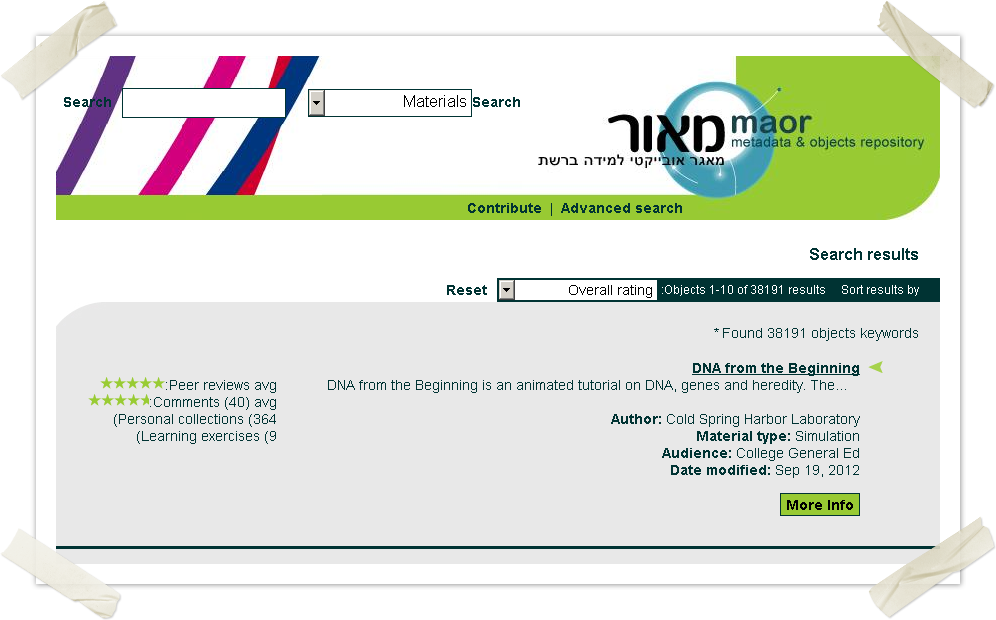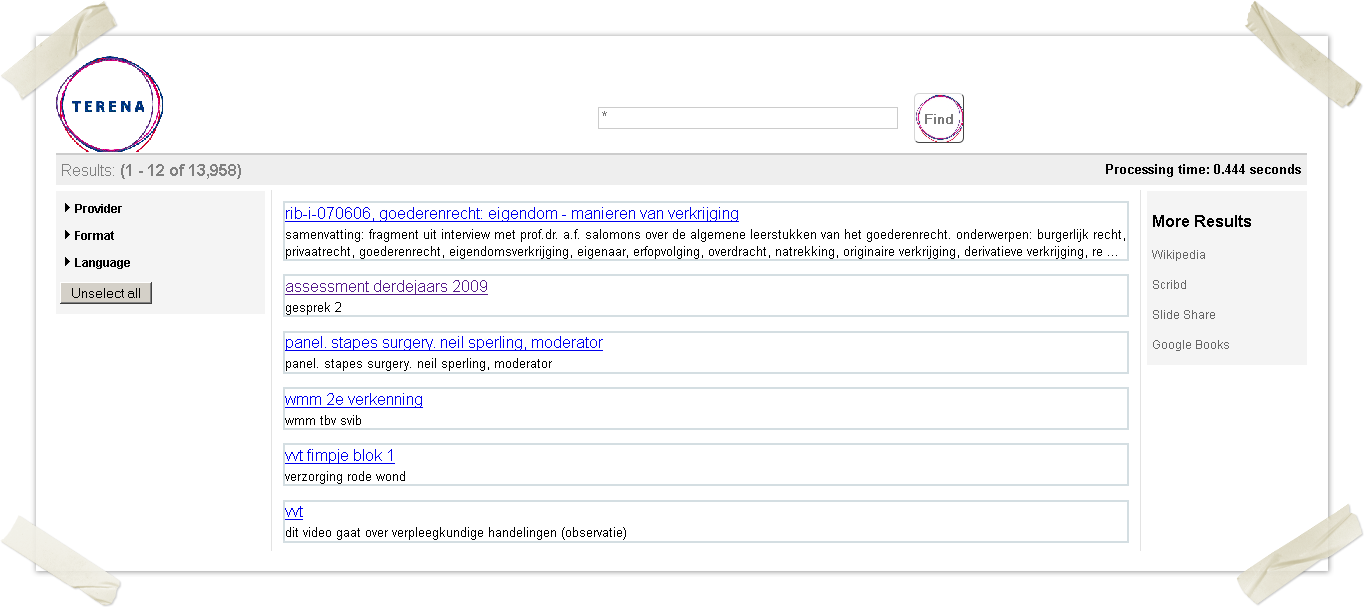The Task Force on Applied Media in Teaching and Learning builds on the mature relationship between NRENs and HEIs in Europe. It is established under the auspices of the TERENA Technical Programme to collect and share ideas, knowledge and experiences on how to support media applied to pedagogical (e-learning) as well as to research/scientific purposes.
Fro more information check out the TF-Media website.
TF-Media Open Educational Resource portal pilot
Motivations
There is a large interest around the world in establishing and maintaining national (as well as multi-national) learning object repositories as exemplified by the number of existing repositories, organizations building and sustaining them, contributors integrating learning objects in repositories, and users of these learning objects. The fundamental reasons are: the growing educational demands in all countries, the limited capacity of face to face education to fulfill the demand in a timely manner, the effort and cost involved to build multimedia learning materials, and the new possibilities offered by the Internet.
While it is a fact that millions of materials can be found on the Internet using search engines like Google, there is no guarantee that a query will lead to trustable material on which high quality education can be built. Not to mention copyright and licensing issues. Well managed learning object repositories that aggregate high quality content offer a solution to this problem. TERENA TF-Media group focuses on multimedia learning object repositories only.
Credit: http://www.globe-info.org/
Objectives
Connecting the World and Unlocking the Deep Web - Create a one-stop-shop (broker) for national learning resource organizations, each of them managing and/or federating one or more learning object repositories within the country. TERENA OER portal initiative addresses the gap between the national repositories and the emerging global repositories (e.g., GLOBE) by establishing an European level metadata repository (i.e. aggregation point) for the national repositories acting in the R&E community. The European level repository will be a metadata repository only, the content remains in its original content repository.
TERENA is willing to make a suite of online services and tools available to its members for the exchange of learning resources' metadata, and facilitates the access to the worldwide Open Community (i.e. GLOBE) guided by the following principles:
- Keep the barrier of entry to TERENA OER low and participation high.
- Provide open specifications and community source code as much as possible, openly shared among and beyond community members.
- Use open standards, where appropriate, and contribute back to the development of these standards based on experiences and best practices.
- Respect and build on European values.
- NRENs' common face to global repositories (i.e. GLOBE)
- Operate as a community of peers.
Credit: http://www.globe-info.org/
Benefits
The expected benefits for the end-users (students and teachers) are as follows:
- More effective and motivating learning scenarios (learners & trainees).
- Better productivity and new philosophy of collaboration (authors of pedagogical material).
- Better communication and co-working schemes (researchers).
- Possible factor for harmonizing education & training policies throughout Europe.
- Spare public money by re-using open learning resources.
The pilot project milestones
- TERENA creates a European level, open source, metadata aggregation broker/portal that leaves the content (i.e. the objects) in its source domain and harvest the metadata from the national level up to the pan-European level. The portal might be hosted and operated by one or more TERENA member organizations.
- TF-Media defines the minimum requirements for a common metadata schema (e.g., 8 LOM fields) and the way how metadata can be harvested (e.g., OAI-PMH protocol)
- Start collecting metadata from the national repositories (primarily from NRENs participating in the pilot) and make them available via the TERENA portal.
- TERENA OER applies for the GLOBE membership.
- Potential service enhancements (e.g., Creative Common licensing), and value added components (e.g., integrated player, better user interface, representation of search targets).
Detailed milestones, timing, etc. to be defined.
List of interested participants
- SWITCH (with SWITCHcast)
- FCCN (with Banco do Video)
- ISEP (with MELOR)
- RedIRIS (with ARCA)
- University of Vigo (with DSpace)
- IUCC (with MAOR)
- NIIF (with Videotorium)
- GRENT (with Ariadne)
Q&A
Q: What can be the role of an NREN?
A: To bring the learning resources' information (metadata only, not the object itself) at the higher (i.e. European) level.
Q: Why should the national repository join TERENA OER (i.e. what is the additional value of TEREAN)?
A: To step from the national level to the pan-European and later global (i.e. via GLOBE) level of aggregation. Create the critical mass.
Q: How can I convince lecturers to share their content?
A: Tell them not to share the whole lecture but just some chunks of it as a Learning Object. In return, they will be able to re-use LOs from other lecturers to enrich their presentation.Quality assured, licensed content.
Q: What is the actual Business Case for NRENs?
A: Universities use public money to create lecture content. Sharing, enriching and re-using the content made available by lecturers eventually spares time, efforts, and public money.
Q: What is the benefit of TERENA OER over Goole Search?
A: Deep search can be done on rich metadata that can find content that is most likely hided from Google Search or other web search engines.
Meeting minutes
- Task Force on Applied Media in Teaching and Learning (TF-Media): 25 June 2012
- Task Force on Applied Media in Teaching and Learning (TF-Media): 21 September 2012
- 3rd meeting planned...
1st VC Minutes (25 June 2012)
We've just had a very productive discussion about the practical steps of the TF-Media Open Educational Resource portal pilot.
Please find the recording at http://uvigo.adobeconnect.com/p1t9d4507u8/
We've kicked off the pilot with some initial agreements however, there are still many open questions and details that need to be clarified in the near future. Stay tuned!
NOTES:
25 June 2012 @ 14.00-15.45 CET
List of participants: Andy (SWITCH), Gytis (KUT), Nikos, Giannis (GRNET); Vicente (UVigo); Eli (IUCC); Jack (TAU); Peter (TERENA)
- The importance of open sharing of educational resources was acknowledged. Many national and global initiatives were mentioned such as ARIADNE, GLOBE, MAOR, etc...
- The layered model of repositories was explained by Eli (IUCC). We (TERENA) should focus on the step between the national layer and the pan-European layer. Global peers must then be considered.
- Andy (SWITCH) noted that we should equally focus on both; how to reach out to the national community and how to aggregate at the pan-European level.
- It was agreed that the TERENA repository must be a metadata/paradata repository only. The content/object must be kept at the original location. Only the metadata of fully open materials should be harvested, in principle. The main focus is on the aggregation of audio/video content repositories in the first step (e.g., no scientific papers, publications, etc.).
- The TERENA OER portal can have enhanced, rich media search functionality (deeper than Google search) and maybe a hosted video playback option (noted by Vicente). Jack (TAU) added that maybe a content upload feature would also be an option at the aggregate layer (home for homeless concept).
- Gytis (KUT) mentioned that Creative Common licensing should be included. It was agreed that licensing is important.
- It was agreed to set up some metadata aggregating points for testing purposes:
1) Vicente (UVigo) agreed to set up a test installation of DSpace and maybe PuMuKit on top.
2) Giannis (GRNET) agreed to set up a test installation of ARIADNE tools.
3) Eli (IUCC) agreed to set up a test installation of MAOR duplicate.
- In parallel with these, an open call for content providers (i.e. NRENs/Unis with recorded lectures) will be sent out. These repositories will be connected to the three test installation above.
- See the relevant TERENA Compendium 2011 data at TER-C11-complete-web.pdf
- For the pilot, the 8 standard LOM metadata fields can be used but a common agreement on the metadata schema is needed for the long run. LOM records can be transported between systems using a variety of protocols, perhaps the most widely used being OAI-PMH.
- Peter (TERENA) will follow up with IUCC, UVigo and GRNET on the test implementations and inform the mailing list about the progress.
DRAFT
OPTION 2) In order to collect the metadata from the repositories participating in the pilot project the ARIADNE infrastructure and services (www.ariadne-eu.org/content/services) could be used.
Credit: Giannis (GRNET)
2nd VC Minutes (21 September 2012)
We've just had the second very productive discussion about the practical steps of the TF-Media Open Educational Resource portal pilot. No recordings have been made.
NOTES
21 September 2012 @ 11.00-12.30 CET.
List of participants: Zenon, Nikos, Giannis (GRNET); Carlos (UPV); Vicente (UVigo); Eli (IUCC); Jack (TAU); Peter (TERENA)
1.) MAOR-based pilot portal installation done by IUCC: http://maor.iucc.ac.il/t_materials.php?keywords=*
- Eli (IUCC) gave a brief overview about MAOR. MAOR is a national metadata and object repository used in Israel. Several institutional content repositories are attached to MAOR nationally.
- The importance of having a pan-European level repository to reach the critical mass and successfully participate in global repositories was emphasized. The layered model should include the institutional, national, pan-European and global aggregation levels.
- Eli demonstrated the pilot portal installation based on MAOR (see the screenshot)
- All the important metadata is included but not the content itself. In addition to the metadata, paradata (e.g., comments, ratings, etc.) can also be included (see on the left hand side) that is collected by the user community and added to the object.
- The participating repositories can be connected to the MAOR-based portal online via API or offline. It was mentioned that the automated, easy metadata export function is essential for the participating repositories.
- There was a question about the added value of the TERENA OER to the national repositories. Jack (TUA) explained that reaching the critical mass is important.
- Eli (IUCC) added that there are millions of contents e.g., in GLOBE and it is hard to find anything without good quality metadata (i.e. YouTube syndrome). Good quality metadata is the key although we should consider the minimum set of metadata (in the pilot) for basic search.
- The MAOR-based pilot portal is the very first, basic installation for test/demo purposes. Later on, value-added features can be implemented such as web services, APIs, inclusion of YouTube channels, etc.
- Carlos (UPV) added that the university staff (professors) can hardly be convinced to directly participate in the TERENA OER portal simply because the YouTube hits are ranked higher in Google search and universities rather upload their lectures to YouTube education channels. However, it is possible to automatically harvest metadata from the university repositories without engaging with the universities.
2.) DSpace-based portal with PuMuKit at University of Vigo
- Vicente (UVigo) gave a brief introduction to DSpace. DSpace is being used at University of Vido as as institutional repository.
- Professors are not really keen on searching materials in the repository for the moment. They prefer Google, perhaps because they only know Google.
- Stepping up from the institutional level to the national and pan-European level might help promoting better our content repositories. Filling the gap between the national level and the global level is the major role of the TERENA OER.
- TERENA OER can have value added benefits compared to Google search, such as the deeper search in metadata and the clearly licensed materials. Creative Common licensing is the potential way forward, must be added to the portal in the future.
- Eli (IUCC) commented that the service provider view is different from the end-user view. TERENA OER must be considered as a provider. Links between objects, information about who searches for what, who comments on what, etc. are all very important for the provider.
- Vicente (UVigo) noted that from the end-user point of view, added features such as embeded video player to the portal or mosaic thumbnail representation of the search targets are important. Must be considered in a later phase as enhancements.
- DSpace is only used for aggregation, no content enrichment is included. It is about the enrichment of the user experience and not the enrichment of the content itself.
- Vicente (UVigo) summarized that the DSpace-based implementation is better for institutional purposes rather than for a pan-European aggregation portal. He will contribute to the pilot with valuable comments from the end-users perspective.
- It was agreed to drop the DSpace-based implementation option!
3.) ARIADNE-based pilot portal installation done by GRNET: http://83.212.100.142:8080/terena-finder/?query=*
- Giannis (GRNET) stressed that the common metadata format and the agreement on the minimum set of metadata is important. Analysis of the metadata schemes is needed!
- Giannis will set up a mini-survey for the metadata analysis (5 questions) that can be discussed and sent out to the repository owners.
- To prof the concept, GRNET implemented an ARAIDNE-based pilot portal without engagement with the providers and without proper analysis of the harvested metadata. The OAI-PMH targets were harvested automatically from 2 providers (one Dutch and one Polish).
- Giannis demonstrated the pilot portal installation based on ARIADNE (see the screenshot)
- As it can be seen from the results, the automatically harvested metadata has poor quality. Not sufficient for a pan-European aggregation portal purposes. It has been proofed and agreed that extensive metadata analysis, common metadata set agreement and engagement with the repository owners (i.e. providers) is needed.
- ARIADNE is only a specification and a set of protocols; a software stack to harvest and index metadata. It has a GoogleSerach-like user interface at the moment.
- The modular architecture helps to add new services to the portal easily.
- Peter (TERENA) said that the initial idea was to compare the MAOR-based and ARIADNE-based implementations, evaluate them with the criteria of a pan-European portal in mind, and implement the TERENA OER pilot portal based on the wining platform. Eli and Giannis commented that the two tools can even be combined as some of the features can nicely complement each other.
- Eli said that e.g., ARIADNE can be used to harvest metadata automatically from the internet (open PMH targets, YouTube channels) while MAOR can be used to harvest metadata from the national repositories engaged with the portal.
- It was agreed to dedicate the next coming meeting of the group to the discussion about how the two platform implementation can be combined.
- Peter (TERENA) will set up the next meeting and send out the open invitation to the TF-Media group.
- After the meeting Michael Stücheli (SWITCH) contacted Peter and offered to harvest metadata from the SWITCHcollection repository. Michael, Eli and Giannis were put in touch.
- In the meantime, Eli and Giannis will try and harvest good quality metadata for both portal implementations from Greece (GRNET), Israel (IUCC), and Switzerland (SWITCH) national repositories.
- Peter (TERENA) will write a news item about the TERENA OER portal pilot and invite other national repositories to participate.
***


